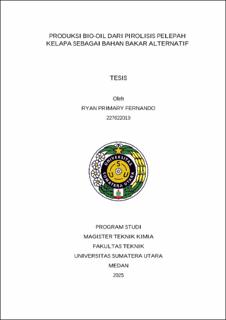| dc.description.abstract | Energy is an important issue that needs to be addressed in Indonesia. The rapid economic growth and increasing population indirectly have a significant impact on energy consumption. The utilization of biomass has become one of the alternative solutions for generating renewable energy. One type of biomass that can be used as a renewable energy source are the coconut fronds, which contains cellulose (39.05%), hemicellulose (22.49%), and lignin (21.46%). The conversion of coconut fronds into energy can be carried out through pyrolysis, which produces bio-char, bio-oil, and non-condensable gases. This study aims to: (1) analyze the composition of bio-oil produced from the pyrolysis of coconut fronds at various pyrolysis temperatures and time; and (2) evaluate the effect of pyrolysis temperature and time on the characteristics of bio-oil from coconut frond pyrolysis as an alternative energy source. The pyrolysis of coconut fronds was conducted at temperatures of 400°C, 450°C, and 500°C with time variations of 60 minutes, 120 minutes, and 180 minutes. The compositional analysis using GC-MS showed that the resulting bio-oil consists of various hydrocarbon compounds. Phenols were the main components (67.04-78.22%), followed by furans (5.30-14.14%), ketones (4.63-11.28%), acids (4.36-6.51%), ethers (1.42%), and other compounds (1.09-5.69%). Increasing the pyrolysis temperature and duration was found to increase the bio-oil yield. The highest bio-oil yield was obtained at a pyrolysis temperature of 500°C for 180 minutes. Under these conditions, the bio-oil had a water content of 20.32%, a density of 1,177.7 kg/m³, a kinematic viscosity of 1.247 cSt, an acid number of 0.583, and a calorific value of 27.204 MJ/kg. The bio-oil produced, particularly at 400°C, 450°C, and 500°C for 180 minutes, closely approached the ASTM D7544 standard, which is the standard for pyrolysis bio-oil. | en_US |


